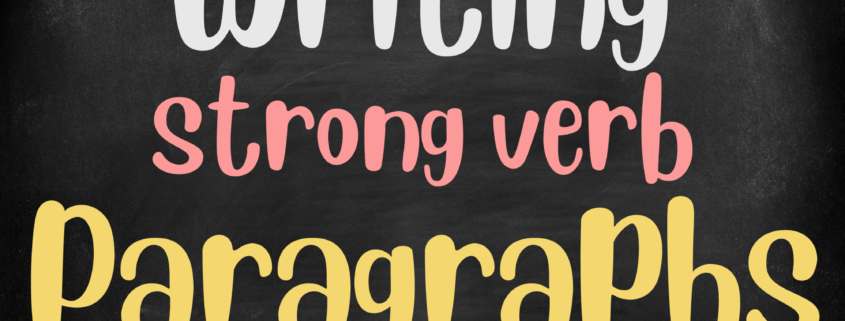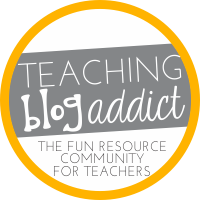Strong Verb Paragraphs ~ Effective Narrative Writing Exercise for Middle School ELA
Sometimes, we need short writing assignments, rather than long ones to fit everything into our ELA class time. Writing strong verb paragraphs is an effective narrative writing exercise for middle school ELA because it is quick and fun. As ELA teachers, we have so much to cover each nine weeks. It seems impossible to have students write narratives, poems, arguments, as well as expository and informative pieces, which are all part of the ELA standards.
Tammy and I have been teaching for a long time, and while we certainly don’t know it all, we have figured out a few things. One way that we cover the writing standards is by adding short and fun writing exercises, like strong verb paragraphs.
What are strong verb paragraphs?
Strong verb paragraphs are paragraphs that consist of seven sentences that only allow strong verbs in the middle five sentences. Students can write these paragraphs independently or with a partner. Along with an interesting narrative prompt, provide students with the following rules.
- Write a paragraph that has seven sentences.
- Only your first and last sentences can have helping verbs or a linking verb in them. The other sentences must have strong action verbs.
- Choose the most vivid verbs, ones that help your reader picture something. You may use the list of helping verbs to help you avoid them.
- Underline the verb in each sentence.
- Do not repeat any action verbs in your paragraph. In other words, each sentence needs to have its own original verb.
- Read back over your paragraph to make sure you do not have any fragments or run-on sentences.
It is helpful to provide students with a list of helping verbs and linking verbs. Also, before allowing students to jump in and write their own strong verb paragraph, provide them with a good example. You can even write one together as a class first!
Why have your students write strong verb paragraphs?
This exercise teaches students to choose their words wisely, essentially making them better writers for life! Writing the paragraphs takes one class period, instead of weeks, making this the perfect writing exercise for middle school ELA classes. What makes these fun are the prompts that you provide and the challenge to complete it correctly. At first, your students may find it hard to write sentences without linking verbs or helping verbs, but encourage them that as they practice, they will get better. Another thing that makes this exercise fun is that kids usually love hearing their paragraph read aloud. They will beam with pride as their story is read aloud and usually laugh at all of the funny sentences that their classmates wrote too. Here are some sample narrative prompts for strong verb paragraphs:
- Write a paragraph telling about a time an alien visited our school.
- Write a paragraph telling about a time a food fight broke out in the lunchroom.
- Write a paragraph telling about a time a group of kids spent the night in a haunted house.
Before Writing the Paragraphs, Begin with Sentences
Before your students write strong verb paragraphs, you may want to begin with sentences. Present students with sentences that have a verb that isn’t specific and then read another sentence with a strong action verb that can be visualized. Look at the following examples:
Suddenly, my dog, Meatball, ran through the living room.
Suddenly, my dog, Meatball, bulldozed through the living room.
I made my way through the sea of people to take a better look.
I wormed my way through the sea of people to take a better look.
The next step is to teach students to take sentences that have linking verbs that tell and not show and teach them to transform those sentences into sentences that show instead of tell. Turning sentences with linking verbs into sentences with action verbs is a little bit harder, but once students see examples and watch you brainstorm and model how to do this, they will feel confident in crafting these sentences themselves.
Take a look at the following examples:
Example sentence with a linking verb that tells: He was mad.
To guide students in revising this sentence, ask students what actions mad people do. Make a list of these actions, and then rewrite the sentence replacing the linking verb was with these words.
He slammed his book down on the desk, stomped across the room, and slammed the door on his way out.
Explain to the class that with this sentence, you don’t have to tell that the boy was mad. We know it based on his actions. The sentence with the strong verbs shows instead of tells!
Here’s another example:
The troll was ugly.
The ugly troll’s green teeth jutted out over his long, flaky chin. The warts on his nose multiplied by the hour, and his razor-sharp toenails scraped the ground when he walked.
After these whole class and individual practices with sentences, you’ll be ready for the strong verb paragraphs. Consider writing one as a whole class together first, then assigning one to a small group or to students working with a partner.
Click here to grab a printable copy of the strong verb paragraph rules. If you want a complete resource, complete with a presentation for teaching, strong verb mini lessons, printable strong verb prompts, and example paragraphs, check out our Strong Verb Paragraph resource on TpT.
We use strong verb paragraphs during the first nine weeks. If you would like to see exactly what we teach in the first nine weeks, click here to download our free first nine weeks plans. If you’d like to see our yearly plans, click here to download a glimpse into our 7th grade ELA yearly plans.
If you’re looking for an effective process-approach method to teach your students to write text dependent analysis essays, we have a complete course, complete with instructional videos for you and EVERYTHING needed to teach the entire process to your middle schoolers. Click here to enroll in the first section of the course completely free! If you like the free course, consider asking your administration to purchase the complete course.





